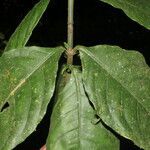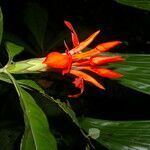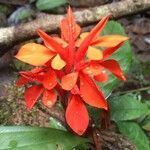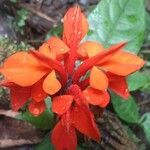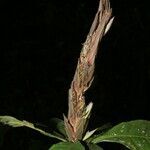Erect, suffrutescent herb or shrub, to 1 m tall. Younger stem subquadrangular, glabrous to velutinous, older stem terete. Petiole 1-3.5 cm long, glabrous; blade elliptic to ovate, 8-15 x 3.5-6.5 cm, apex acuminate, base attenuate and decurrent on the petiole, sometimes obliquely so, frequently thickened, glabrous on both surfaces primary vein and secondary veins sometimes bearing a few subappressed trichomes, upper surface nitid, often brilliant polished green, lower surface pale green, reticulation obscure, margin entire or undulate. Inflorescence terminal, spikes solitary or sometimes 2, quadrifarious, 6-13 x 1.5-3 cm (excluding corollas); peduncle short, to 3 mm long, puberulous; rachis similar, flattened and slightly excavated at nodes; bracts imbricate, elliptic or ovate, 20-30 x 7.5-10 mm, apex acute, base cuneate, margin with 2-4 pairs of short teeth (1-1.5 x 0.5 mm) on each side, green, puberulous and glandular on both surfaces, reticulation prominent on inner surface; bracteoles narrowly lanceolate, to 10 x 0.5 mm, puberulous, striate-ridged. Calyx lobes 10-12 mm long, posterior lobe oblong, 2.5-3 mm wide, cuspidate, anterior and lateral lobes linear-lanceolate, 1-1.5 mm wide, all lobes puberulous with striate ridges culminating at base in callus tissue ca. 1 mm thick; corolla red, orange-red or scarlet, 50-60 mm long, sparingly puberulous, tube 40 mm long, 3 mm wide, upper lip erect, oblong-ovate, 20 x 10 mm, bilobed, lobes minute, triangular, 0.5 mm long, forming a partial hood over anthers, middle lobe of lower lip elliptic, 20 x 12 mm, apically obtuse, lateral lobes elliptic-ovate, to 12 x 7.5 mm, acute, puberulous on both surfaces; stamens 35-50 mm long, filaments pubescent with eglandular trichomes, thecae 4-5 mm long, pubescent with cobwebby trichomes; ovary puberulous at apex, style to 46 mm long, sparingly puberulous with ascending trichomes. Capsule 16 mm long, sparingly puberulous; seeds hispidulous.
More
Suffrutescent herb to shrub, erect, 1 m tall; young stems tetrangular, older stems terete; younger stems glabrous to velutinous. Leaves elliptic, 8-30 cm long, 3-12.5 cm wide, apically acuminate, basally attenuate, occasionally obliquely decurrent, glabrous except for occasional puberulence along the veins, the costa and lateral veins prominent, reticulations plainly visible on the upper surface and obscure on the lower margins, undulate to entire; petioles to 1 cm long, glabrous. Inflorescences in mostly terminal, quadrifarious spikes, to 15 cm long and 2 cm wide excluding the corollas; rachis puberulous, flattened at the nodes. Flowers sessile; 1 bract subtending each flower, imbricate, elliptic or ovate, to 3 cm long by 1 cm wide, the apex acute, the base cuneate, puberulous-glandular on both surfaces, reticulations prominent on the inner surface, the margins ciliolate, ser-rate, the teeth to 1.5 mm long; 2 bracteoles subtending each flower, narrowly lanceolate, to 10 mm long and 0.5 mm wide, puberulous on both surfaces, striate ridged; calyx 5-merous, 1 cm long, the posterior segment oblong, 2.5 mm wide with a 3-toothed apex, the lateral and anterior segments linear-lanceolate, 1 mm wide, all segments puberulous with striate ridges culminating at the base in callus tissue ca. 1 mm thick; corolla red, orange red, or scarlet, the tube to 4 cm long and 3 mm wide, bilabiate, the upper lip to 2 cm long and 1 cm wide above base, oblong-ovate, apiculate at the apex, forming a partial hood over the anthers, the lower lip 3-lobed, elliptic, the middle lobe 2 cm long, 1.2 cm wide, the apex acute, the lateral lobes elliptic ovate, to 1.2 cm long and 0.75 cm wide, the apex acute, puberulous on both surfaces; style to 4.6 cmn long, sparingly puberulous with ascending hairs, the ovary puberulous at the apex. Capsules 1.6 cm long, sparingly puberulous; seeds hispidulous.
